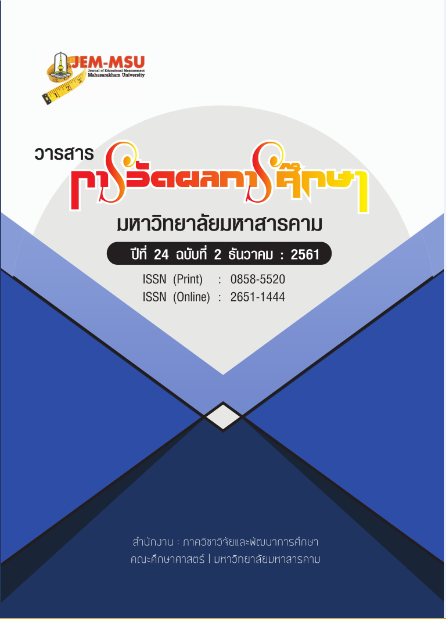Developing the Administration Model on STEM Education for Schools under the Office of the Secondary Education Service Area 25
Main Article Content
Abstract
The purposes of this research were: 1) to identify the elements and indicators of STEM education administration in schools under the Office of the Secondary Education Service Area 25, 2) to investigate the current and desirable situations on STEM education administration in schools under the Office of the Secondary Education Service Area 25, and 3) to develop the STEM education administration model for schools under the Office of the Secondary Education Service Area 25. The research was divided into 3 phases. Phase 1, five experts were selected using purposive sampling technique to identify both the elements and indicators of STEM education administration in schools. Phase 2, investigation the current and desirable situations on STEM education administration in schools. First step, 260 samples were selected using the stratified random sampling from such various groups as school directors, deputy school directors, heads of academic affairs department, heads of science department, heads of mathematics department, and heads of career and technology department from 84 schools under the Office of the Secondary Education Service Area 25 to answer the questionnaire; next step, study the Best Practice characteristics of STEM education administration in schools under the Office of the Secondary Education Service Area 25, twelve school administrators from 3 different schools were selected using purposive sampling technique to be interviewed. Phase 3, develop the STEM education administration model for schools under the Office of the Secondary Education Service Area 25, nine experts were selected using purposive sampling technique to perform the focus - group discussion in order to reach the finished model. In conducting the research, questionnaire, semi-structure interview, focus-group form, and model evaluation form were used as tools to collect the data. The statistics employed in data analysis were the mean, standard deviation PNI Modified and content analysis.
The results showed that:
- there were 5 elements and 27 indicators of STEM education administration in schools under the Office of the Secondary Education Service Area 25. Those elements were; 1) policy formulation and organization planning with 6 elements, 2) curriculum development and learning management with 6 elements, 3) teachers and educational personnel development with 5 elements, 4) supervision and evaluation with 5 elements, and 5) networking for development with 5 elements. The suitability and feasibility of elements and indicators were at high level (
= 4.31).
- The current situation of STEM education administration was at moderate level (
= 3.41) and the desirable situation was at high level (
= 4.39). Need assessment index was at high level (PNI = 1.43)
- The model could be divided into 5 sections as; 1) concept, principles, and objectives, 2) elements of STEM education administration for schools under the Office of the Secondary Education Service Area 25 consisted of five categories which were external environment, input, process, results or achievement, and output, 3) application plan, 4) assessment, and 5)conditions for achievement. Overall, the suitability and feasibility of the model were at high level (
=4.21).
Article Details
The content and information contained in the published article in the Journal of Educational Measurement Mahasarakham University represent the opinions and responsibilities of the authors directly. The editorial board of the journal is not necessarily in agreement with or responsible for any of the content.
The articles, data, content, images, etc. that have been published in the Journal of Educational Measurement Mahasarakham University are copyrighted by the journal. If any individual or organization wishes to reproduce or perform any actions involving the entirety or any part of the content, they must obtain written permission from the Journal of Educational Measurement Mahasarakham University.
References
กมลฉัตร กล่อมอิ่ม. (2559). การจัดการเรียนรู้แบบบูรณาการสะเต็มศึกษา สำหรับนักศึกษาวิชาชีพครู. วารสารศึกษาศาสตร์ มหาวิทยาลัยนเรศวร.
จำรัส อินทลาภาพร และคณะ. (2558). “การศึกษาแนวทางการจัดการเรียนรู้ตามแนวสะเต็มศึกษาสำหรับผู้เรียนระดับประถมศึกษา.” Veridian E-Journal Silpakorn University,
ดิเรก วรรณเศียร. (2545). การพัฒนาแบบจำลองแบบสมบูรณ์ในการบริหารโดยใช้โรงเรียนเป็นฐานสำหรับสถานศึกษาขั้นพื้นฐาน. วิทยานิพนธ์ปริญญาดุษฏีบัณฑิต สาขาการบริหารศึกษา,
คณะครุศาสตร์ จุฬาลงกรณ์มหาวิทยาลัย.
ทองอินทร์ วงศ์โสธร. (2547). ทฤษฎีและแนวปฏิบัติในการบริหารการศึกษา: ทฤษฎีระบบ. กรุงเทพโรงพิมพ์ : มหาวิทยาลัยสุโขทัยธรรมาธิราช.
พรทิพย์ ศิริภัทราชัย. (2556). STEM Education กับการพัฒนาทักษะในศตวรรษที่ 21. วารสารนักบริหาร Executive Journal.
พูลสุข หิงคานนท. (2540). การพัฒนารูปแบบการจัดองค์การของวิทยาลัยพยาบาล สังกัดกระทรวงสาธารณสุข. วิทยานิพนธ์ดุษฎีบัณฑิต จุฬาลงกรณ์มหาวิทยาลัย.
วิจิตร ศรีสอ้าน. (2523). “ปรัชญาและพัฒนาการบริหาร” ในหลักและระบบการบริหารการศึกษา หนวย 1-5, เลม 1 หนา 1-24. นนทบุรี: โรงพิมพ์มหาวิทยาลัยสุโขทัยธรรมาธิราช.
สถาบันส่งเสริมการสอนวิทยาศาสตร์และเทคโนโลยี. (2559). STEM Education Thailand. [ออนไลน์], เข้าถึงได้จาก: http://www.stemedthailand.org/ (2559, 30 กรกฎาคม).
สถาบันส่งเสริมการสอนวิทยาศาสตร์และเทคโนโลยี.(2559). คู่มือจัดกิจกรรมสะเต็มศึกษา ระดับชั้นมัธยมศึกษาปีที่ 1-3. กรุงเทพฯ : องค์การค้า ของ สกสค.
สำนักงานเขตพื้นที่การศึกษามัธยมศึกษา เขต 25. (2560). สำนักงานเขตพื้นที่การศึกษามัธยมศึกษา เขต 25. [ออนไลน์]. ได้จาก : http://www.secondary25.go.th
[สืบค้นเมื่อ วันที่ 7 กันยายน 2560].
สำนักงานเลขาธิการสภาการศึกษา. (2559). ข้อเสนอนโยบายการส่งเสริมการจัดการศึกษาด้านสะเต็มศึกษาของประเทศไทย. กรุงเทพมหานคร : พริกหวาน กราฟฟิก.
สมาน อัศวภูมิ. (2537). การพัฒนารูปแบบการบริหารการประถมศึกษาระดับจังหวัด. วิทยานิพนธดุษฎีบัณฑิต จุฬาลงกรณมหาวิทยาลัย.
สุธรรม ธรรมทัศนานนท์. (2559). รูปแบบการบริหารจัดการตามหลักปรัชญาของเศรษฐกิจพอเพียง (สถานศึกษาพอเพียง) ของสถานศึกษา สังกัดคณะกรรมการการศึกษาขั้นพื้นฐาน. วารสารศึกษาศาสตร์ มหาวิทยาลัยบูรพา.ปีที่ 28 ฉบับที่ 1 มกราคม- เมษายน 2560.
Hoy, W. K. and Miskel, C. G. ( 2012). Educational Administration: Theory, Research, and Practice. (6th ed.). New York: McGraw–Hill.
Kast, F. E. and Rosenzweig, J. E. (1985). Organization and Management: A Systems and Contingency Approach. (3 rd ed.).
New York: McGraw–Hill.
Lunenburg.F. C. and Ornstein, A. C. (2008). Educational Administration: Concepts and Practices. (5th ed.). Belmont, CA: Wadsworth.
Robbins, S. and Mukerji. (1990). Organization Theory: Structure, Design, and Applications. (3rd ed.). Englewood Cliffs, NJ: Prentice-Hall.
President’s Council of Advisors on Science and Technology. (2010). Report to the President “Prepare and Inspire: K-12 Education in Science,
Technology, Engineering, and Math (STEM) for America's Future. [online]. From : http://stelar.edc.org publications.


